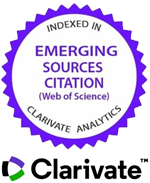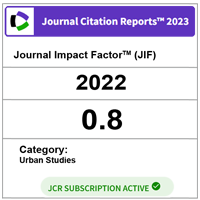Energy-Saving Potential of Daylighting in the Atria of Colleges in Najran University, Saudi Arabia
DOI:
https://doi.org/10.11113/ijbes.v7.n1.421Keywords:
Building atrium, Case study, Daylight illuminance, Clear sky, Energy saving, Lighting control.Abstract
Daylighting is recognised as an effective strategy for enhancing visual comfort and reducing energy used for electric lighting. Najran University, Saudi Arabia, has 15 colleges for males and 10 colleges for females. Each college has several atria and courtyards for introducing daylighting into the hearts of college buildings. However, the electrical lights used in the colleges atria and linked corridors keep on all the daytime. This study is an attempt to investigate the daylight illuminance level and energy-saving potential on the atria and linked corridors when it incorporates a time-scheduling lighting control system. The field measurements were performed in the College of Applied Medical Sciences. The results indicate that daylight illuminance in the atrium spaces are abundant with an average illumination level on the atrium floor varying from 300 lux to 3 600 lux, depending on the time of the day. In the clear sky climate of Najran city throughout the year, the time-scheduling control system is effective and found to contribute to approximately 43 855.2 kWh of annual energy savings in electrical-lighting consumption in the present case study scenario. The total annual energy savings from all 25 colleges at Najran University is 1 096 380 kWh/year, which results in a cost saving of approximately 93,512.86 USD. There would be additional substantial savings from other atria and courtyards in all of the college buildings throughout the campusReferences
A. C. Menezes, A. C. (2014). Estimating the energy consumption and power demand of small power equipment in office buildings. Energy and Buildings, 75: 199–209.
Amin, A.T.M.N., Jarusombut, S., Thuy, T.T.B. & Thanaprayochsak ,W. (2006). Environmental Management Measures For Influencing Human Behaviour Towards Sustainable Development. Regional Development Dialogue. 27(1): 85–100.
Abdou, O. A. (1997). Effects of Luminous Environment on Worker Productivity in Building Spaces. Journal of Architectural Engineering. 3(3): 124-132.
Alshaibani, K. (2001). Potentiality of Daylighting In A Maritime Desert Climate: The Eastern Coast of Saudi Arabia. Renewable Energy. 23(2): 325-331. doi: https://doi.org/10.1016/S0960-1481(00)00166-X
Aries, M., Aarts, M., & van Hoof, J. (2015). Daylight and Health: A Review Of The Evidence And Consequences For The Built Environment. Lighting Research and Technology. 1–22. doi:DOI: 10.1177/1477153513509258.
Atif, M. R., & Galasiu, A. D. (2003). Energy Performance Of Daylight-Linked Automatic Lighting Control Systems In Large Atrium Spaces: Report On Two Field-Monitored Case Studies. Energy and Buildings. 35(5): 441-461. doi: https://doi.org/10.1016/S0378-7788(02)00142-1
Chow, S., Li, D., Lee, E., & Lam, J. (2013). Analysis and Prediction Of Daylighting And Energy Performance In Atrium Spaces Using Daylight-Linked Lighting Controls. Applied Energy. 112: 1016-1024. doi: https://doi.org/10.1016/j.apenergy.2012.12.033
Costanzo, V., Evola, G., & Marletta, L. (2017). A Review of Daylighting Strategies in Schools: State of the Art and Expected Future Trends. Buildings. 41(7): 1-21. doi:10.3390/buildings7020041.
Frank, S., Doug, L., Jeff, D., & Josh, C. (2014). The Use And Environmental Impact Of Daylighting. Journal of Cleaner Production. 85: 462-471. doi: https://doi.org/10.1016/j.jclepro.2014.03.092.
Grondzik, W. T., & Kwok, A. G. (2015). Mechanical and Electrical Equipment For Buildings. Hoboken, New Jersey: John Wiley & Sons.
Halonen, L., Bhusal, P., & Y, S. (2010). Guidebook on Energy Efficient Electric Lighting for Buildings. International Organizations: Aalto University, school of Science and Technology.
Hourani, M., & Hammad, R. (2012). Impact of Daylight Quality On Architectural Space Dynamics, Case study: City Mall – Amman, Jordan. Renewable and Sustainable Energy Reviews. 3579– 3585.
Hua, Y., Oswald, A., & Yang, X. (2011). Effectiveness of Daylighting Design And Occupant Visual Satisfaction in a LEED Gold laboratory building. Building and Environment. 46(1): 54-64. doi:https://doi.org/10.1016/j.buildenv.2010.06.016
IESNA. (2000). The IESNA Lighting Handbook. New York: Illuminating Engineering Society of North America.
Kim, G., & Kim, J. T. (2010). Luminous Impact Of Balcony Floor At Atrium Spaces With Different Well Geometries. Building and Environment. 45(2): 304–310.
Lechner, N. (2015). Heating, Cooling, Lighting: Sustainable Design Methods For Architects. Hoboken, New Jersey: John Wiley & Sons.
Mahdavi, A., Rao, S. P., & Inangda, N. (2013). Parametric Studies on Window-To-Wall RatioforDay lighting Optimisationin High-Rise Office Buildings inKuala Lumpur,Malaysia. Journal of Design and Built Environment.https://ejournal.um.edu.my/index.php/jdbe/article/view/5332 Access on 12June 2019.
Mansour, T. A., Sawalha, S., & Salem, N. (2013). A Mathematical Model for Solar Assisted Automobile A/C Based on Absorption Refrigeration System. International Journal of Mechanical Engineering (IJME). 2(4): 75-86.
Mardaljevic, J., & Nabil, A. (2006). The Useful Daylight Illuminance Paradigm: A Replacement for Daylight Factors. Energy and Buildings. 38(7): 905-913.
Mark, D., & G. Z., B. (2014). Sun, Wind & Light – Architectural Design Strategies (3 ed.). Hoboken, New Jersey: John Wiley & Sons.
Obaid, R., & Mufti, A. (2008). Present State, Challenges, and Future of Power Generation in Saudi Arabia. Energy 2030 Conference. 1 - 6. 10.1109/ENERGY.2008.4781073. 1-6. Atlanta, GA USA.
PE., K. (1991). Efficient Use Of Daylight In Commercial Buildings. Right Light Bright Light. Stockholm, Sweden.
Sabry, H. M. (2006). he Impact of Daylighting- Guiding Systems on Indoor Natural Light Penetration: Simulation Analysis for Light-Shelves . Passive And Low Energy Architecture. 1-6. Geneva Switzerland.
SEEC, S. E. (2018) Buildings. Retrieved from Saudi Energy Efficiency Center: https://www.seec.gov.sa/en/blog/buildings. 12 20 Access on 10 August 2019.
Stanley K.H. Chow, D. H. (2013). Analysis and Prediction Of Daylighting And Energy Performance In Atrium Spaces Using Daylight-Linked Lighting Controls. Applied Energy. 1016–1024.
USGBC, U. G. (2018). Daylighting Strategies. Retrieved from US Green Building Councel: https://www.usgbc.org/education/sessions/daylighting-strategies-4775236. Access on 26 June 2018.
Veronica G., H. (2006). Improving Daylighting Systems for Deep-Plan Commercial Buildings. PhD. Schoole of Design, Queensland University of Technology, Queensland.
WWO, W. W. (2018). World Weather Online. Retrieved from https://www.worldweatheronline.com/. Access on 13 Jan 2019.
YILMAZ, F. Ş. (2016). Proposal of a Façade Design Approach For Daylight Performance Determination In Buildings. A|Z ITU Journal of the Faculty of Architecture. 13(2): 57-64.
Zell, E., Gasim, S., Wilcox, S., Katamoura, S., & Stoffel, T. (2015). Assessment of Solar Radiation Resources in Saudi Arabia. Solar Energy, 119, 422-438. https://doi.org/10.1016/j.solener.2015.06.031
Downloads
Published
How to Cite
Issue
Section
License
Copyright of articles that appear in International Journal of Built Environment and Sustainability belongs exclusively to Penerbit Universiti Teknologi Malaysia (Penerbit UTM Press). This copyright covers the rights to reproduce the article, including reprints, electronic reproductions or any other reproductions of similar nature.
Authors who publish with this journal agree to the following terms:
- This Journal applies Creative Commons Licenses of CC-BY-NC-SA
- Authors retain copyright and grant the journal right of publication with the work simultaneously licensed under a Creative Commons Attribution License that allows others to share the work with an acknowledgement of the work's authorship and publication in this journal.
- Authors are able to enter into separate, additional contractual arrangements for the non-exclusive distribution of the journal's published version of the work (e.g., post it to an institutional repository or publish it in a book), with an acknowledgement of its publication in this journal.
- Authors are permitted and encouraged to post their work online (e.g., in institutional repositories or on their website) prior to and during the submission process, as it can lead to productive exchanges, as well as earlier and greater citation of published work (See The Effect of Open Access).







